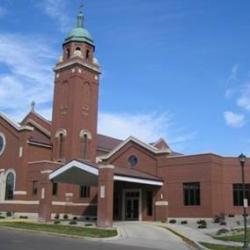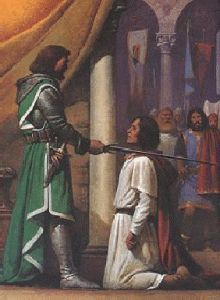
Some people are auditory learners, some visual. Some, like me, relate to the world primarily through the sense of touch. That sense turns out to be the key for the continuation of Jesus’ story as Mark tells it. Touch is what makes the connection the Church has with Jesus real. It’s like the matter of a sacrament, given form by Jesus’ teaching, which alone couldn’t keep the discipleship community together. The memory of Jesus’ touch gathered them once again after they had fallen apart. Jesus’ body connects with ours through a succession of other bodies starting with those who failed Jesus in his greatest need.
Twenty-first in a series on “The Worldly Spirituality of Mark’s Gospel” with help from Ched Myers’ Binding the Strongman: A Political Reading of Mark’s Story of Jesus. The Introduction and a Table of Contents are HERE.
It’s Wednesday, and the chief priests and scribes are looking for a way to put Jesus to death. It won’t be easy because Jesus still has the love of the crowds. But luck favors the temple officials this day. One of the disciples turns traitor. One more day and all of the insiders will betray Jesus one way or another.
A discipleship sacrament and a jar of perfume
Jesus is spending Wednesday in Bethany at the house of Simon the leper. It’s a place from which Jesus’ enemies, worrying about ritual purity and a leprous touch, would keep their distance.
The crowd here isn’t entirely friendly. A woman comes with a jar of expensive perfume to perform a sacred action, a sacrament. She pours it on Jesus’ head. Unknown persons are indignant at the waste of money, which could have been given to the poor. Jesus praises the woman. (Mark 14:3-9)
Myers calls this a story of discipleship. The woman is not following Jesus in the literal sense of being a member of the community. Still, she is going where the male disciples can’t. She is anointing Jesus body for burial, a sacrament the others can’t perform – a thought they can’t accept – but she can. We feel the touch of the unnamed woman’s hands on Jesus’ head. Myers says her “care for Jesus’ body narratively prepares us for the emergence of this body as the new symbolic center of the community.” (359)
But the disciples have not moved away from the temple as the center of their world. One disciple in particular chooses temple over a dead body:
Then Judas Iscariot, one of the Twelve, went off to the chief priests to hand him over to them.” (Mark 14:10)
I see here a serious wound in the line of succession leading out from Jesus but no hint of the traditional idea that Judas was coveting some of that money.
The betrayers and the naked man.
A line of succession is what Jesus needs, disciples to carry on his mission after he is gone. Yet in the last stage of preparing that discipleship community, he predicts its collapse:
All of you will have your faith shaken.” (Mark 14:27)
In spite of denials, Jesus’ prediction comes true. Peter, James, and John sleep through Jesus’ agony in the Garden of Gethsemane. All the disciples flea when Jesus confronts the soldiers and Judas. Peter denies knowing Jesus three times. The succession seems to have stopped.
A curious incident takes place in the midst of this “collapse of the discipleship narrative,” as Myers calls it. (p. 364) A young man wearing only a linen cloth is accosted by the posse arresting Jesus, and he flees, leaving the cloth behind. Other commentators have read a real historical event into this episode, imagining that the young man was Mark himself. But Mark is doing more than recording an odd event, however personal. Whether real or not, the oddness encourages us to believe its meaning will become clear at some point.
Two “young men”
That point is the end of Mark’s story. Mary Magdalene, Mary the mother of James, and Salome go to Jesus’ tomb the day after Sabbath. But it’s past the time for the sacrament of anointing normally given when a person dies. That’s already been done. The women see a young man who is somehow familiar. He’s dressed now in a white robe, white the color of martyrs. He has a message:
You seek Jesus of Nazareth, the crucified. He has been raised. He is not here.
and a command:
Go and tell his disciples and Peter, ‘He is going before you to Galilee; there you will see him, as he told you’ (Mark 16:6-7)
“Young man” lost a linen cloth. “Young man” now wears a white robe. The second incident recalls the first.
The words of the young man at the tomb also recall earlier words of Jesus:
After I have been raised up, I shall go before you to Galilee. (14:29)
Were beginning to see continuity in a discipleship narrative rent asunder by Jesus’ passion and the fearful actions of the disciples.
Continuity in discipleship and Catholic theology
There are other clues in Mark’s story, hopeful portents that the discipleship narrative will resume. There are the ones who experienced the sacrament of Jesus’ healing touch. Jesus touches a leper and contamination goes not, as one expects, from the diseased leper to the clean Jesus but the other way around. Some, like formerly blind Bartimaeus, follow Jesus on the way to the cross. A woman touches Jesus and is cured. Children feel Jesus friendly touch even as the disciples object. A father asks, “Help my unbelief.”
Of course, there are the women, including the one who anoints Jesus’ body for burial. Other women stay to witness the crucifixion while the male disciples were not to be seen. Three go to the tomb and hear the message. The official disciples are failures while Jesus lived, but the discipleship narrative will continue.
Mark’s community knew a discipleship narrative. They were in it. Still they needed to hear something that all these clues have to say, something that, in fact, is an important part of Catholic theology. It’s what we call succession. Mark wasn’t asking people to form a new community inspired by Jesus with all the right qualities. It wasn’t going to be like people today deciding to be a disciple of, say, Socrates or Confucius. They had to be the same community that gathered, with all its faults, around Jesus, the ones whom Jesus touched. Catholic theology needs that physical connection, that sacrament of touch.
Jesus’ body at the center
To be clear, the discipleship narrative does not center around Jesus’ teachings nor around the practices he mandated, not even when that means taking up the cross. It is Jesus’ body at the center, touching and being touched by many. Mark’s community needed to be in touch with Jesus’ body through a succession of touches.
At the beginning I said I relate to the world best through the sense of touch. (I remember the pleasant feeling of walking down a long school corridor, dragging my fingernails against the wall all the way.) I like the words of Catholic teaching that give meaning to the world, but the physical touch, touching Jesus, is my favorite thing about being Catholic.
I’m not worried about the precise working of apostolic succession. That teaching imagines a long line of bishops consecrating bishops supposedly all the way back to the apostles. What matters to me is that I touch Jesus directly and indirectly. Directly and immediately, I touch Jesus in the Sacrament of the Eucharist. I take in my hands the Bread of Life and the Cup of Salvation, of which Jesus said,
This is my body…. This is the cup of the new covenant in my blood.
Indirectly, another sacrament, a line of disciples, extending to the ones who brought me into this world and shared their faith with me, mediates Jesus’ touch to me.
The next post features Jesus’ gift of his body at the Last Supper. It also takes aim at a puzzle concerning Jesus’ final actions. Jesus could have escaped the clutches of the Jerusalem Sanhedrin and the Roman overlords. He didn’t. Should he have? Why didn’t he?
Image credit: Google Images: Healing Hands












